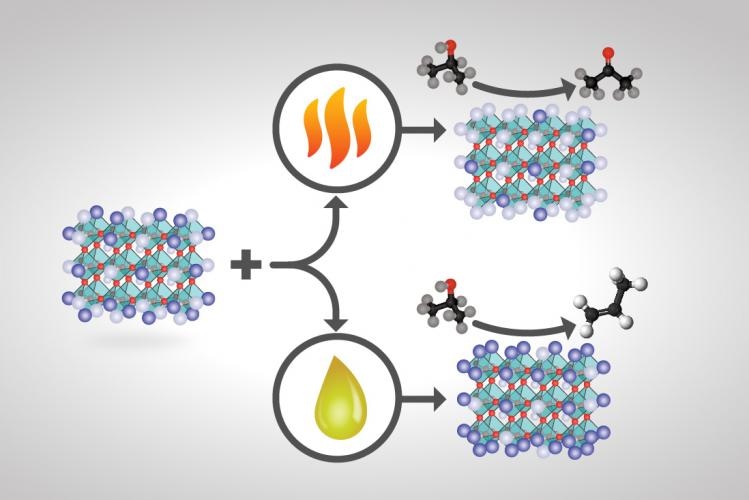Oct 19 2017
According to two studies headed by the Department of Energy’s Oak Ridge National Laboratory, for some crystalline catalysts, what people see on the surface is not always what they get in the bulk.
 Credit: Oak Ridge National Laboratory, U.S. Dept. of Energy; illustrator Adam Malin
Credit: Oak Ridge National Laboratory, U.S. Dept. of Energy; illustrator Adam Malin
The researchers found that treating a complex oxide crystal with chemicals or heat caused different atoms to separate on the surface, that is, surface reconstruction. These differences formed catalysts with dissimilar behaviors, which supported different reaction pathways and finally produced distinct products.
By employing chemical and thermal treatments, catalyst designers are capable of driving industrially important chemical reactions in order to enhance yields of desired products and decrease yields of unwanted products so that post-reaction separation costs can be lowered significantly.
The surface of a catalyst is a playground for the molecules to do the chemical reaction. If you can tune your catalyst to obtain the desired product, i.e., achieve high selectivity, you will reduce the side products. Then you don’t need costly and energy-intensive downstream chemical separation as much.
Zili Wu, Chemist, ORNL
The researchers examined four catalysts of perovskite, a mixed oxide crystal composed of cubic unit cells of the atomic composition ABO3, where A is a rare-earth metal cation (positively charged ion), B is a transition-metal cation and O is oxygen.
Researchers including first co-authors Felipe Polo-Garzon and Guo Shiou Foo reported in the ACS Catalysis journal that treating a perovskite with heat produced a catalyst with more A atoms on its surface. Researchers including first author Polo-Garzon afterward reported in Angewandte Chemie International Edition that treating the same perovskite with chemicals resulted in more B atoms on the surface.
The researchers were the first to systemically examine how different perovskite surface compositions influence acid-base catalysis. The acquired knowledge could lead to selective conversion of biomass into value-added chemicals.
Researchers examined a model reaction, the isopropanol conversion, basically, rubbing alcohol, in order to test the acid-base performance of the perovskite catalysts that are treated. The perovskite could selectively convert the alcohol into propylene, a building block of plastics, via a dehydration reaction, or acetone, an industrial solvent, via a dehydrogenation reaction based on the propylene pre treatment.
“Isopropanol adapts to your catalyst’s surface,” Wu explained. “If you have a basic surface (an AOx-dominated surface), it will do the base-catalyzed reaction (to acetone). If you have an acid surface (a BOx-dominated surface), it adapts to that route (to propylene). So isopropanol is a good probe molecule to tell you the surface composition of the catalyst.”
The tests demonstrated that a broad range of tunability was possible with various treatments. The same perovskite starting material that is subjected to various treatments could produce a desired product, such as propylene or acetone, in a broad range, from 25 to 90%.
In the tests Wu conceived, Foo and Polo-Garzon employed X-ray diffraction to characterize the bulk of a catalyst and several other methods to characterize its surface. In order to learn if element A or B predominated on the surface of perovskite if the catalyst was subjected to chemical or heat pretreatments. Shi-Ze Yang, directed by Matthew Chisholm, performed scanning transmission electron microscopy of catalyst nanoparticles, while Foo employed infrared spectroscopy and adsorption microcalorimetry. Low-energy ion scattering, carried out at Lehigh University, shot an ion at a nanoparticle.
The energy lost while the ion bounced back showed compositional details of the top most surface layer, which is crucial for catalysis. Lessons learned from all these tests about surface composition helped De-en Jiang and Victor Fung in theory-based computations in order to predict reaction pathways. Elizabeth Bickel, a summer student from Tennessee Technology University, and Polo-Garzon performed measurements that confirmed the influence of surface separation on the acid-base catalytic properties of the perovskite material.
What’s next? The investigators are planning to further examine perovskite catalyst surfaces’ reconstruction processes with different termination facets.
The geometry and the composition of the cation and anion [negatively charged ion] are arranged differently when you have different facets. That can give you quite a different chemical reactivity.
Zili Wu, Chemist, ORNL
The investigators are now expanding their work to improve the surface terminations of perovskites in order to understand and improve oxidation and reduction reactions beyond acid-base ones, which can be employed in the conversion of shale gas (mostly methane) into valuable chemicals.